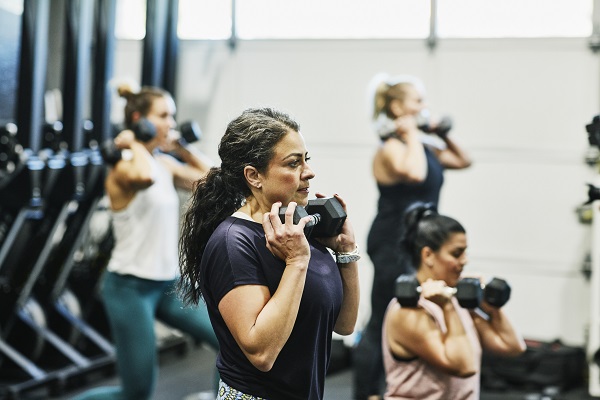-
Walking into most gyms you’ll find the majority of women on the treadmills and bikes, or doing some crunches in the corner. Meanwhile, the weights section is full of ‘muscle bros’ and the occasional ballsy woman who really knows what she’s doing.
It can be intimidating, and overwhelming, to start out.
“A lot of women have a bit of a fear when it comes to weight training, and not knowing what to do. They don’t want to look silly,” says Ange Drake, founder and head coach at 23W, a gym in Melbourne’s northern suburbs dedicated to strength and conditioning coaching for women.
“We’ve also been told through the fitness industry to think that cardio or Pilates is what we should focus on for the ideal body.”
Ask her about this though, and she’ll passionately disagree (along with many other experts in the field). If you want to change your body and your health, weight and strength training should be a key part of your routine.
In fact, it’s a key part of Australia’s physical activity and exercise guidelines. We should all be doing muscle strengthening exercises, at least twice a week: men, women, old and young.
We look at some of the unique benefits of strength training and weights for women, and how to get started with confidence.
It’s time to forget the stereotypes around lifting weights.
“It feels really empowering to be able to move a heavy object and know that you’re progressing and do a little bit more each time.”
Benefits of weight lifting for women
Cardio exercises like running or cycling will get your heart going, and burn lots of calories quickly. Weight training is all about building muscle. Not only will building muscle change the shape of your body, it can help you to reduce the signs and symptoms of many chronic conditions as you age.
Strengthen your bones
One of the most important reasons women should lift weights is to help with bone density. We all tend to lose bone density as we age, but the hormonal changes that come with menopause can cause a significant decline for women.
This decline in bone density can leave women susceptible to osteoporosis, or ‘brittle bones’ and put you at risk of nasty fractures later in life. One of the best ways to counteract that decline? Weight-bearing and resistance-training (exercises like weights).
“Bone density and muscle strength go hand in hand,” says Ange. “Starting at any age can play a huge preventative factor for things like osteoporosis.”
“But it does get harder to build muscle as we age, particularly after 50. So, the earlier you can get into some strength training and build a good base, the better. It’ll reduce that muscle loss, and help you to stay really fit and active as you become a granny.”
Boost your mood
It’s now well known that exercise is great for your mental health, as it releases chemicals like endorphins amongst other things. But weight lifting in particular can provide a certain buzz that other exercises don’t.
“From a psychological point of view, I think there's a certain amount of confidence you get from being able to lift weights. It just feels really good. It feels really empowering to be able to move a heavy object and know that you're progressing and able to do a little bit more each time,” says Ange.
Take on everyday life (and stay strong as you age)
Every day, our muscles help us get through life. Everything from getting in and out of a chair, to mowing the lawn, and carrying the kids (or grandkids) around.
Building a good muscle base in the gym makes all those everyday tasks just a little easier. Especially as you age.
Burn more calories at rest
You’ve probably heard that cardio workouts are the best type of exercise to burn calories and lose weight. But if that’s your goal, don’t write off weight training. While cardio may burn more calories while you exercise, weight training tends to increase the number of calories you burn afterwards and when you’re at rest.
“If weight loss is your goal, the biggest change you can make is your diet,” says Ange. “And when it comes to exercise, a mix of cardio and strength training including things like weights is the most effective approach.”
How to start weight lifting for women
Start small
As with any sport, or new skill, it’s important to start small and build up with weight lifting. That could mean starting with a 20-minute workout a couple of times a week, says Ange.
“Generally when starting out, it’s usually a much lighter weight and anywhere between 8—15 repetitions of each exercise. Start with two sets of each exercise, then as you get stronger over time, maybe adding a third set and adding more weights from there.”
“You want the last few reps of each set to feel hard, but you shouldn’t be feeling like your body is a mess at the end of a session,” she said.
Use body weights or free weights and build up
Before you go and grab that barbell off the rack, start using your own body weight or free weights to build up your strength. Bodyweight exercises might include things like push ups, or squats — exercises that use your own body weight to work against gravity. Free weights include dumbbells (starting from 1kg) and kettle bells which you can incorporate into all kinds of movements.
“Using your body weight or free weights naturally encourages a lot more stabilisation through the movement. So yes, you might be doing a squat, but you will be engaging the rest of your body to stabilise those weights as well,” says Ange.
If you can, get some coaching from a professional
If you’re new to the gym and starting out for the first time with weight training, some professional help to get you started can be invaluable.
Using weights the right way and learning good technique will not only ensure you get more out of the workout, it will help to prevent injury.
“Lifting is a skill, just like anything else,” says Ange. “It's not something that you walk into a gym and just being able to inherently do. Start by learning the basics and look for a facility that really prides itself on teaching the foundations first, before you even touch a barbell.”
Why more women are embracing strength training (and why you should too)


Like what you're reading?
Explore more articles like this one in our Adapt Issue of Live Better magazine.